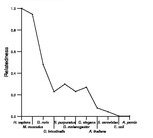
| Name: DOC2A | Sequence: fasta or formatted (400aa) | NCBI GI: 47078261 | |
|
Description: double C2-like domains, alpha
|
Referenced in: ER, Golgi, and the Secretory Pathway
| ||
|
Composition:

Amino acid Percentage Count Longest homopolymer A alanine 8.2 33 2 C cysteine 2.5 10 1 D aspartate 6.5 26 3 E glutamate 6.2 25 2 F phenylalanine 2.2 9 2 G glycine 8.5 34 7 H histidine 2.8 11 1 I isoleucine 4.8 19 1 K lysine 6.0 24 3 L leucine 12.0 48 2 M methionine 1.5 6 1 N asparagine 3.2 13 1 P proline 6.5 26 2 Q glutamine 2.5 10 2 R arginine 6.5 26 3 S serine 6.5 26 2 T threonine 5.2 21 2 V valine 4.2 17 1 W tryptophan 1.0 4 1 Y tyrosine 3.0 12 1 |
Comparative genomics:
Search single species RefSeq proteins at NCBI
Search summary 
Figure data | ||
Related human proteins:Protein Relative score Description Self-match 1.000 double C2-like domains, alpha DOC2B 0.596 double C2-like domains, beta RPH3A 0.499 rabphilin 3A homolog isoform 1 RPH3A 0.499 rabphilin 3A homolog isoform 2 LOC390213 0.380 PREDICTED: hypothetical protein LOC390213 LOC390213 0.368 PREDICTED: similar to hCG21066 LOC390213 0.368 PREDICTED: similar to hCG21066 SYT7 0.193 synaptotagmin VII SYT2 0.183 synaptotagmin II SYT2 0.183 synaptotagmin II SYT1 0.180 synaptotagmin I SYT1 0.180 synaptotagmin I SYT1 0.180 synaptotagmin I SYT5 0.175 synaptotagmin V SYT6 0.164 synaptotagmin VI SYT4 0.158 synaptotagmin IV SYT10 0.156 synaptotagmin X SYT3 0.154 synaptotagmin III SYT3 0.154 synaptotagmin III SYT3 0.154 synaptotagmin III SYT11 0.145 synaptotagmin XI SYT9 0.145 synaptotagmin IX SYTL4 0.125 synaptotagmin-like 4 SYTL4 0.125 synaptotagmin-like 4 SYT17 0.107 B/K protein SYTL5 0.105 synaptotagmin-like 5 isoform 1 SYTL5 0.105 synaptotagmin-like 5 isoform 2 SYTL5 0.105 synaptotagmin-like 5 isoform 1 SYT16 0.105 synaptotagmin XIV-like SYTL2 0.091 synaptotagmin-like 2 isoform bHuman BLASTP results (used to prepare the table) | |||
Gene descriptions are from NCBI RefSeq. Search results were obtained with NCBI BLAST and RefSeq entries. When identical proteins are present, the self-match may not be listed first in BLASTP output. In such cases, the table above has been reordered to place it first.
See About the Figures for the scoring system used in the figure above right. The same scoring system was used in the table of BLASTP results.
Guide to the Human Genome
Copyright © 2010 by Stewart Scherer. All rights reserved.
